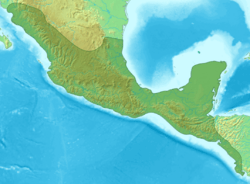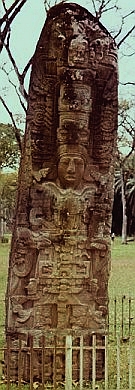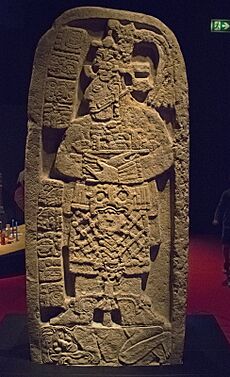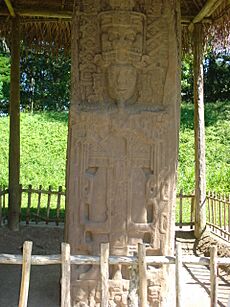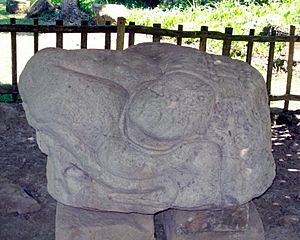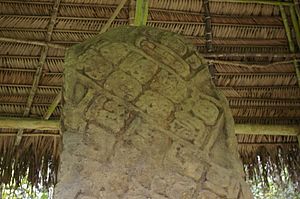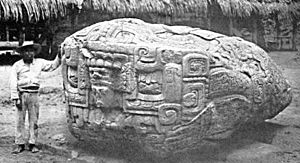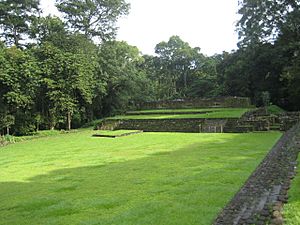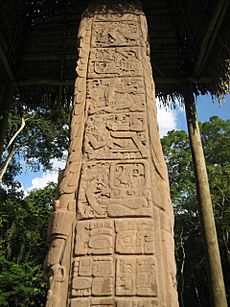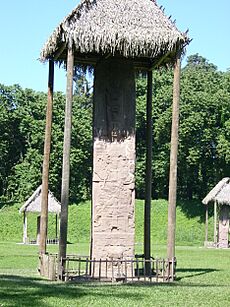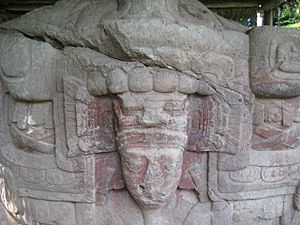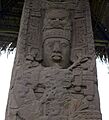Quiriguá facts for kids

Stela D, north side, from Quiriguá, representing king K'ak' Tiliw Chan Yopaat
|
|
| Location | Izabal Department, Guatemala |
|---|---|
| Coordinates | 15°16′10″N 89°2′25″W / 15.26944°N 89.04028°W |
| History | |
| Periods | Late Preclassic to Early Postclassic |
| Cultures | Maya civilization |
| Official name | Archaeological Park and Ruins of Quiriguá |
| Type | Cultural |
| Criteria | i, ii, iv |
| Designated | 1981 (5th session) |
| Reference no. | 149 |
| Region | Latin America and the Caribbean |
Quiriguá is an ancient Maya city in south-eastern Guatemala. It covers about 3 square kilometers along the Motagua River. The main part of the city is about 1 kilometer from the river. During the Maya Classic Period (AD 200–900), Quiriguá was important for trade routes.
People lived here by 200 AD. Big buildings started to appear in the 8th century. By 850, building stopped. Quiriguá looks a lot like the nearby city of Copán in its buildings and sculptures. Their histories are also closely linked.
Quiriguá grew quickly in the 8th century. This happened after its king, K'ak' Tiliw Chan Yopaat, won a big battle against Copán in 738. The powerful king of Copán, Uaxaclajuun Ub'aah K'awiil (also known as "18-Rabbit"), was captured. He was then sacrificed in Quiriguá's Great Plaza. Before this, Quiriguá was under Copán's control. But after the victory, it became independent.
The buildings at Quiriguá are not huge. However, the site is famous for its many sculptures. These include the tallest stone monument ever built in the New World. Because of its important history, UNESCO made Quiriguá a World Heritage Site in 1981.
Contents
Where is Quiriguá Located?

The site is named after a nearby village. It is about 200 kilometers northeast of Guatemala City. Quiriguá is in the Izabal department and sits about 75 meters above sea level.
It is on the north bank of the lower Motagua River. This area is a wide flood plain. The river used to flow close to the city. Now, it flows 1 kilometer south of the main area. Quiriguá is 48 kilometers north of Copán. It is also about 15.7 kilometers northwest of the border with Honduras.
The local rock is a strong red sandstone. The Maya used this for their buildings and monuments. This stone is very tough. It allowed sculptors to create the tallest freestanding stone monuments in the Americas. Quiriguá was built right over the Motagua Fault. Earthquakes damaged the city in ancient times.
Who Lived in Quiriguá?
Most people in Quiriguá were not ethnic Maya. They belonged to groups from the Intermediate Area to the east. The Maya elite, however, were in charge.
During the Late Classic Period, the city center had about 400 to 500 people per square kilometer. The highest population was around 1200 to 1600 people. This low number means Quiriguá was a center for people living in the countryside.
The population grew fast after Quiriguá became independent in 738. But it was never a huge city. In the 9th century, the number of people dropped sharply. Eventually, the city was abandoned.
What Was Quiriguá's Economy Like?
The Motagua River flows from the western Guatemalan Highlands. Quiriguá was perfectly placed to control the trade of uncut jade. Most jade was found in the middle Motagua Valley. The city also controlled other important goods moving along the river. This included cacao, which was grown as a local crop.
Even though cacao was for trade, maize was the main local crop. It was a key part of the Maya diet. Maize also likely served as a payment to Copán when Quiriguá was its vassal. Copán needed these resources.
There is also proof of obsidian trade. This stone came from the Ixtepeque area, further up the Motagua River. Quiriguá was at a crossroads. It connected trade from the highlands to the Caribbean coast. It also linked Copán to the big cities of the Petén Basin.
Who Were Quiriguá's Rulers?
The dates below are all from the AD period. Maya inscriptions sometimes show a number for rulers. This number tells their place in the line of kings. For example, a "five" means the ruler was the fifth in line.
| Name (or nickname) | Ruled | Dynastic succession no. |
|---|---|---|
| "Tok Casper" | 426–? | 1 |
| Tutuum Yohl K'inich | c. 455 | ? |
| "Ruler 3" ("Turtle Shell") | c. 480 | ? |
| "Ruler 4" ("Basket Skull") | ?–? | 3? |
| Mih Toh | 493– | 4? |
| K'awiil Yopaat ("Ruler 5") | c. 653 | ? |
| K'ak' Tiliw Chan Yopaat ("Cauac Sky" or "Kawak Sky") | 724–785 | 14 |
| "Sky Xul" | 785 – c. 795 | 15 |
| "Jade Sky" | c. 800 – c. 810 | 17? |
Quiriguá's History
Early Beginnings
Quiriguá was settled as early as 400 BC. No buildings from this time have been found. But many early objects, like figurines, show people lived here. Early pottery from Quiriguá is like that found in Copán. This shows Quiriguá was part of the wider Maya region from early on.
Texts from Tikal, Copán, and Quiriguá suggest that Tikal founded Quiriguá and Copán. This was part of Tikal's plan to expand. Quiriguá's recorded history starts in 426 AD. On September 5, K'inich Yax K'uk' Mo' became king of Copán. Just three days later, he put "Tok Casper" on the throne of Quiriguá. This shows Quiriguá was under Copán's rule from the start. It was likely founded to control the Motagua River trade route for Copán and Tikal.
For the next few centuries, Quiriguá's main buildings were simple. An early monument from 480 shows Copán's king overseeing a ritual. This proves Quiriguá remained a vassal of Copán.
A Time of Change
Quiriguá had a quiet period from the early 500s to the mid-600s. This might be linked to Tikal's own struggles. There's also evidence Quiriguá was attacked. Some monuments were damaged on purpose, suggesting invaders. No new monuments were built during this time.
In the 6th or early 7th century, a big flood covered the site with mud. Only buildings on higher ground, like Group A, remained in use. A new center for Quiriguá grew from one of the smaller complexes.
Things started to improve around 653. A new monument was built by King K'awiil Yopaat. Quiriguá kept in touch with Copán. Major building work began in the acropolis, including the first ballcourt.
Quiriguá's Golden Age
Quiriguá had always been under Copán's control. In 724, Copán's king, Uaxaclajuun Ub'aah K'awiil, put K'ak' Tiliw Chan Yopaat on Quiriguá's throne. But by 734, K'ak' Tiliw Chan Yopaat started calling himself "holy lord" instead of "subordinate lord." He also began using Quiriguá's own special symbol. This showed he wanted independence. He could only do this if Quiriguá had a powerful ally.
This local rebellion was part of a bigger fight between two Maya "superpowers": Tikal and Calakmul. In 736, the high king of Calakmul visited K'ak' Tiliw Chan Yopaat. Copán was an old ally of Tikal. This visit suggests Calakmul helped Quiriguá rebel. They wanted to weaken Tikal and gain access to the rich Motagua Valley trade route. Quiriguá grew quickly after this, showing it was getting outside help.
In 738, everything changed. K'ak' Tiliw Chan Yopaat of Quiriguá captured the powerful king of Copán, Uaxaclajuun Ub'aah K'awiil. This king had put K'ak' Tiliw Chan Yopaat on his throne. There's no sign either city was attacked. Quiriguá seemed to gain its independence and control of trade routes. An inscription suggests the capture happened on April 27, 738. Quiriguá also burned Copán's sacred wooden images. This implies K'ak' Tiliw Chan Yopaat ambushed the Copán king. Maya gods' statues were often carried into battle.
The captured king was taken to Quiriguá. On May 3, 738, he was publicly executed. Sacrificing such a powerful ruler made Quiriguá and its royal family very important. It showed Quiriguá was the new main city in the southeastern Maya region. After this, Quiriguá started a huge building program. Its sculptures looked like Copán's, perhaps even using captured Copán sculptors. The population of Quiriguá grew fast after 738. But it was always a small center, with probably never more than 2,000 people.
In the Late Classic, alliances with Calakmul often meant military support. Copán, a much stronger city, did not attack Quiriguá back. This suggests Copán feared Calakmul's army. Calakmul was far enough away that K'ak' Tiliw Chan Yopaat wasn't afraid of becoming its full vassal. The alliance helped both: Calakmul weakened Tikal, and Quiriguá gained freedom.
K'ak' Tiliw Chan Yopaat, who changed his city's fate, died on July 27, 785. Zoomorph G is his memorial stone. It says he was buried 10 days later. "Sky Xul" became the next king 78 days after K'ak' Tiliw Chan Yopaat died. He was likely K'ak' Tiliw Chan Yopaat's son. His rule lasted 10 to 15 years. During this time, he dedicated three large zoomorph sculptures and two altars. These are amazing examples of Maya stonework. "Sky Xul" died between 795 and 800.
Decline and End
Little is known about "Jade Sky," the last recorded ruler of Quiriguá. The city's power was already fading. Two small stelae from his rule show the kingdom lacked resources for grand monuments. However, "Jade Sky" did build two of the largest structures in the acropolis.
Quiriguá stayed independent from Copán and thrived until the early 9th century. Relations between the two cities improved by 810. King Yax Pasaj Chan Yopaat of Copán visited Quiriguá for a special ritual. But 810 was also when the last hieroglyphic texts were carved in Quiriguá. Some building continued, but less.
After this, Quiriguá became quiet. It was part of the larger Classic Maya collapse. It lost its purpose when trade on the Motagua River stopped. Within a few years, Quiriguá was mostly empty. Many sites in the Motagua Valley also declined or were abandoned.
Later Occupations
In the early Postclassic Period (around 900–1200 AD), people from the Caribbean coast of the Yucatán Peninsula and Belize lived in Quiriguá. They might have been Chontal Maya, who controlled trade routes. They added new parts to the acropolis. Finds from this time include a reclining chacmool sculpture and pottery from Yucatán. These show a link to the distant city of Chichen Itza. Some early copper bells and ornaments were also found here.
Quiriguá's Modern History
The first European to write about Quiriguá was English architect Frederick Catherwood in 1840. He made drawings of two stelae. These were published in John Lloyd Stephens's book in 1841. Quiriguá was the first site they could say they discovered.
Explorer Alfred Maudslay visited Quiriguá in 1881. He was so impressed that he became interested in Central American archaeology. He returned three more times, clearing monuments and taking photos. He made molds of the hieroglyphic texts.
In 1910, the United Fruit Company bought the land around Quiriguá for banana farms. They set aside 75 acres around the main area as an archaeological park. More archaeological work happened from 1910 to 1914. Copies of Quiriguá's stelae were shown at an exhibition in San Diego in 1915. The Carnegie Institution also worked at Quiriguá from 1915 to 1934.
Quiriguá was named a National Monument in 1970. In 1974, it became an Archaeological Park. From 1974 to 1979, a big project by the University of Pennsylvania and National Geographic Society excavated the acropolis and cleaned monuments. Quiriguá became a UNESCO World Heritage Site in 1981. One of its stelae is even on the Guatemalan 10 centavo coin.
Today, the 34-hectare park is open to the public. It has a car park, a museum, and restrooms.
Exploring the Site
Quiriguá's Architecture
After its victory over Copán in 738, King K'ak' Tiliw Chan Yopaat rebuilt the main part of Quiriguá. He made it look like Copán. The acropolis, palace, and ballcourt are all at the south end of the Great Plaza. The main area has three plazas. The Great Plaza is the northernmost. It is 325 meters long, making it the largest plaza in the Maya region.
At the south end of the Great Plaza is the Ballcourt Plaza. It is surrounded by buildings linked to the acropolis. The Acropolis Plaza is inside the acropolis itself. The area west of the Ballcourt Plaza was likely a docking area by the river. The southern Great Plaza might have been a marketplace. Many ancient wells were found near the city center. They were built in the 8th century.
- Platform 1A-1 is a huge platform in the northern Great Plaza. It is 100 by 85 meters and 0.5 meters high. It was built by K'ak' Tiliw Chan Yopaat. This platform held stelae A, C, D, E, F, and Zoomorph B.
- Mound 1A-3 marks the northern edge of the Great Plaza. It was 82.5 by 20 meters and 7 meters high. A wide stairway led up from the plaza.
- The acropolis is the biggest building complex at Quiriguá. It is at the southern end of the city. Building started in 550 and continued until 810. The acropolis was a palace where the elite lived and worked. It includes structures 1B-1, 1B-2, 1B-3, 1B-4, 1B-5, and 1B-6.
- Wall 1B-sub.1 is also called the K'inich Ahau Wall. It was a free-standing wall over 23 meters long. It had five masks of sun gods and serpents. This wall was finished around 750.
- Ballcourt 1B-sub.4 was found buried under other buildings in the acropolis. This is rare. It was the first ballcourt at the site, built in the mid-7th century. It was like the ballcourts at Copán. K'ak' Tiliw Chan Yopaat buried it when he expanded the acropolis.
- Structure 1B-1 forms the southern edge of the Acropolis Plaza. It has three entrances leading to small rooms. These rooms have steps with hieroglyphs. The building's outer and inner glyphs show the last date recorded at Quiriguá: June 810. "Jade Sky" built this.
- Structure 1B-2 is smaller than 1B-1 and next to it. It was a small, decorated home. This was probably K'ak' Tiliw Chan Yopaat's residence.
- Structures 1B-3 and 1B-4 are on the west side of the Acropolis Plaza. Only their lower walls remain. Between them is an older wall with sun god masks.
- Structure 1B-5 is north of the Acropolis Plaza. It is the largest building at Quiriguá. It has a wide stairway leading to seven connected rooms. "Jade Sky" built this.
- Structure 1B-6 is east of the Acropolis Plaza. It held a shrine for ancestors. A tomb with an elite burial was found under it. The person had jade in their teeth. This tomb dates to the Early Classic.
- Ballcourt 1B-7 was built by K'ak' Tiliw Chan Yopaat. It replaced the buried ballcourt. It is in the Ballcourt Plaza. Its east-west direction is unusual for Maya ballcourts.
Amazing Monuments
Quiriguá's monuments are huge stelae. They are carved from single blocks of red sandstone. This stone came from quarries 5 kilometers away. The hard rock allowed sculptors to make detailed, almost 3D carvings. After defeating Copán in 738, Quiriguá's sculptures looked like Copán's.
The giant stelae would have been seen from the Motagua River. This showed the city's new power to traders. The monuments have long texts with complex and beautiful Maya writing. Some glyphs are full figures of gods. By the late 8th century, Quiriguá developed its own style. They made large boulders carved into mythical animals. These are called zoomorphs. Later kings made these after K'ak' Tiliw Chan Yopaat died.
Some monuments also have altars and decorations on buildings. Most Quiriguá monuments are grand and formal. Traces of red paint have been found. Many were likely painted red, a color for birth and sacrifice.
- Stela A was put up in 775 by K'ak' Tiliw Chan Yopaat. It forms a pair with Stela C.
- Zoomorph B was dedicated in 780 by K'ak' Tiliw Chan Yopaat. It is a huge boulder carved into a half-crocodile, half-mountain beast. Its text uses full-figure glyphs. It is 4 meters long.
- Stela C was also put up in 775 by K'ak' Tiliw Chan Yopaat. Its text mentions an early king from 455. It also refers to the Maya calendar's starting date: August 13, 3114 BC.
- Stela D dates to 766. It has rare, detailed full-figure hieroglyphs on its sides. It is about 6 meters tall.
- Stela E is in the Great Plaza. K'ak' Tiliw Chan Yopaat dedicated it on January 24, 771. It is 10.6 meters tall, including the buried part. This huge stone weighs about 65 tons. It might be the largest free-standing carved stone in the New World. It fell in 1917 and broke in 1934 during an attempt to raise it. It shows K'ak' Tiliw Chan Yopaat on its front and back.
- Stela F is a huge 7.3-meter-high sandstone carving. It shows K'ak' Tiliw Chan Yopaat and has texts. It dates to 761. It was the tallest Maya monument until Stela E was built 10 years later.
- Zoomorph G is K'ak' Tiliw Chan Yopaat's memorial. "Sky Xul" dedicated it. It shows the dead king's face coming from a jaguar's mouth. The text tells about his death and burial.
- Stela H dates to 751. Its glyphs are in a rare mat pattern, copied from Copán. It is heavily damaged.
- Stela J was put up by K'ak' Tiliw Chan Yopaat in 756. It is 5 meters tall.
- Altar L is a simple stone from 653. It mentions King K'awiil Yopaat and "Smoke Imix," the 12th king of Copán.
- Altar M is the earliest monument by K'ak' Tiliw Chan Yopaat. It is important because he claimed the title of "holy lord" on it. This started his fight for independence from Copán. It was dedicated on September 15, 734. It looks like a monster's head.
- Altar N is a small sculpture like Altar M. It looks like a turtle shell with a skeletal head. It shows the underworld god Pawatun.
- Zoomorph O is a crocodile-mountain monster. King "Sky Xul" dedicated it in 790.
- Zoomorph P (called The Great Turtle by Maudslay) was dedicated in 795 by "Sky Xul." It is a masterpiece of Maya art, weighing about 20 tons. It shows "Sky Xul" sitting in the jaws of a monster. The carving is very detailed. Its text describes Quiriguá's founding under Copán's king.
- Altar Q and Altar R are two small stone disks. They were likely markers for the earliest ballcourt.
- Stela S is the earliest surviving monument by K'ak' Tiliw Chan Yopaat, from 746. It is very eroded. It shows K'ak' Tiliw Chan Yopaat on the front. It is 2.8 meters tall.
- Stela T was dedicated in 692 by an unknown ruler. It is badly eroded.
- Stela U is from Group A. It shows a king and dates to April 18, 480. It mentions a ritual overseen by Copán's king. It was broken in two pieces, likely on purpose during an attack.
- Monument 25 is a plain stone column. It is about 2.5 meters long.
- Monument 26 is a stela from 493. It mentions the third and fourth rulers of Quiriguá. It was broken on purpose in ancient times.
- Monument 29 and Monument 30 are eroded stone sculptures. They are thought to be from the Late Preclassic period. They look like human-like figures or monkeys.
Images for kids
-
The southern Maya area, showing the locations of Quiriguá and Copán
-
Detail of the north face of Stela E, depicting K'ak' Tiliw Chan Yopaat holding a God K sceptre
See also
 In Spanish: Quiriguá para niños
In Spanish: Quiriguá para niños
- El Puente
- List of megalithic sites
- Manche Ch'ol
- Yopaat


